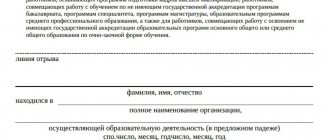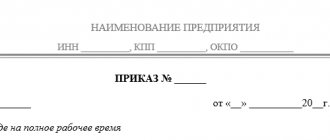If an employee decides to terminate his employment relationship and has unused days of annual paid leave, he can consider 2 options for resolving the situation: receiving monetary compensation or taking a vacation with subsequent dismissal based on a special order from the manager.
In the first case, the employee writes a statement to terminate the employment contract at his own request and, after working for two weeks, resigns and receives compensation for vacation days not taken off.
In the second case, the employee writes an application for leave with subsequent dismissal and goes on vacation, having previously received vacation pay, while the date of termination of the employment relationship is considered the last day of vacation.
Who can count on vacation followed by dismissal?
An employee of an organization, based on Article 127 of the Labor Code of the Russian Federation, can rightfully submit an application in which he is free to reflect his intention to take unused annual leave, after which his dismissal will follow. But this is only possible if the dismissal does not occur due to cases involving the employee’s fault.
Guilty actions established by law are listed in Art. 81 of the Labor Code of the Russian Federation and contain the following provisions:
- The employee committed a gross violation once in the process of performing his labor duties.
- The employee, without good reason, has repeatedly shied away from performing his direct job duties and, in addition to everything, has been subject to disciplinary action.
- The employee came to his workplace or to the place where he must perform his work activities in a state of intoxication of various kinds (drug, alcohol, toxic intoxication).
- The employee was absent from his workplace all day without a valid reason or was absent from his workplace for more than 4 hours.
- The employee performed actions that caused serious consequences: accident, accident; or intentionally acted in a manner that endangered the lives of other employees.
- An employee who learns a secret as a result of fulfilling his labor obligations discloses it , while secrets (of a state, commercial, official nature) are protected by law.
- The employee stole someone else's property, deliberately destroyed or damaged property, or squandered it, as determined by the court.
- An employee whose activities are related to educational work has committed an immoral offense that is further incompatible with the continuation of his work.
- An employee who, by the nature of his activity, is related to values: monetary or commodity, took actions that entailed undermining the manager’s trust in him.
Salary deductions
Separately, it should be noted that when taking days off outside of the schedule, management has the right to withhold a certain amount from wages.
This is due to the fact that the person has not completed the calendar year at the end of which vacation is due. So in such a situation, you should not be surprised that some of the money from your salary will be lost. The company has the right to withhold up to 20% of total earnings, and in special cases the figure can reach up to 50%. But it should also be noted that if 20% exceeds half of the amount paid on redundancy, then the money cannot be withheld.
Some organizations do not want to waste time contacting the tax service due to the deduction of funds from wages. In this case, they let the employee go on vacation, without taking into account the lack of production by day. This debt will be automatically written off after 3 years from the date of occurrence, because it will no longer be repayable.
How to prepare documents?
Statement
To apply for leave followed by dismissal, you must notify the employer in writing by writing a free-form application addressed to the manager. The application must indicate the duration of the vacation, its beginning and end, with a mandatory note that the vacation will be followed by dismissal.
Attention: an employee of the organization is obliged 2 weeks before the possible date of leaving work, but no later, to inform the employer of his desire to resign on his own initiative.
This provision is spelled out in Art. 80 Labor Code of the Russian Federation. At the same time, he can declare his right to use unused vacation to be reviewed.
Has a standard form:
General Director of Karmaran LLC V.P. Kukushkin
From economist Marina Konstantinovna Babaeva
Statement
On granting leave with subsequent dismissal.
I ask you to terminate my employment contract on my initiative on November 24, 2013 and provide me with 14 calendar days of vacation from November 11 to November 24, 2013, followed by dismissal.
Babaeva M.K. (painting)
09.11.2013
Reference
An employee can safely submit his application for leave, which will be followed by dismissal, regardless of the vacation schedule available in the organization. But in this case, he must understand that the employer has the right to refuse and not provide unused leave at his disposal, since the law only provides for the possibility of receiving such leave, but there are no requirements for the mandatory nature of this action.
And at the same time, if an agreement is concluded that mentions the employment contract signed between the company employee and the employer and which contains information about the possibility of the employee receiving a vacation, followed by dismissal, the employer will no longer be able to refuse to implement it.
Agreement
Sample:
Agreement on termination of the employment contract with Babaeva M.K. November 09, 2013 Yaroslavl
Limited Liability Company "Karmaran" (LLC "Karmaran"), hereinafter referred to as the "Employer", represented by General Director Vladimir Paramonovich Kukushkin, acting on the basis of the Charter, on the one hand, and economist Babaeva Marina Konstantinovna, hereinafter referred to as "Employee" , on the other hand, have entered into this agreement as follows:
- The parties agreed to provide the Employee with annual paid leave from November 11 to November 24, 2013, followed by dismissal and termination of the employment contract dated August 17, 2012 No. 29 by agreement of the parties (Clause 1, Part 1, Article 77 of the Labor Code of the Russian Federation).
- The day of dismissal of the Employee is the last day of his vacation - November 24, 2013.
- The Employee's last day of work is November 10, 2013.
- This agreement comes into force from the moment of signing.
- This agreement is drawn up in two copies having equal legal force, one of which is kept by the Employer, the second by the Employee.
Employer Kukushkin V.P. (signature) Employee Babaeva M.K. (signature) Babaeva M.K. received a copy of the agreement to terminate the employment contract. 09.11.2013
If, while an employee is employed, the thought of quitting comes to him, he can confidently write a statement to be fired of his own free will. This application must be submitted to the employer in person or sent by mail, taking into account that a period of two weeks will be calculated from the moment the letter is received by the organization.
There is an opinion that it is necessary to receive 2 statements from the resigning employee:
- A letter of resignation, with a specified reason, which explains why he seeks to terminate the employment contract.
- About the intention to take a vacation and then resign, indicating the dates of the proposed vacation.
But in reality, this is not necessary and, as stated earlier, just an application for leave, with a note that it will be followed by dismissal, will be enough.
Order
Having received an application from the employee, the employer issues orders, there are two of them:
- On granting leave (for this order, forms No. T-6 or No. T-6a are used, which were approved by the State Statistics Committee of Russia in its Resolution No. 1 dated January 5, 2004)
- On dismissal (for this order, unified forms No. T-8 or No. T-8a are used, which were also approved by the State Statistics Committee of Russia in its Resolution No. 1 dated January 5, 2004).
The note
Due to the fact that the law does not provide for a special form of order for issuing leave followed by dismissal, it is possible to issue such an order in any form (instead of two orders, create one).
Sample:
Limited Liability Company "Karmaran" LLC "Karmaran"
ORDER
November 09, 2013 No. 23-ok Yaroslavl
On granting leave with subsequent dismissal
In connection with the granting of leave to economist M.K. Babaeva followed by dismissal,
I ORDER:
- Provide economist Marina Konstantinovna Babayeva with basic annual paid leave from November 11 to November 24 in the amount of fourteen calendar days for the period of work from August 17, 2012 to August 16, 2013.
- Terminate the employment contract dated August 17, 2012 No. 29 with Babaeva M.K. on November 24, 2013.
- Pay all amounts due to Babaeva M.K., November 10, 2013.
Grounds: Articles 84.1 and 127 of the Labor Code, agreement to terminate the employment contract with Babaeva M.K. dated November 09, 2013.
General Director V.P. Kukushkin
Babaeva M.K. was familiarized with the order on 11/09/2013.
Note-calculation
After drawing up the order, the HR department employee draws up two calculation notes:
- vacation note;
- notice of dismissal;
For this, there are unified forms No. T-60 and No. T-61, which were approved by the State Statistics Committee of Russia by Decree No. 1 dated January 5, 2004. All that remains is to enter the data in the work book and close the employee’s personal file.
SZV-STAZH
Starting from 2021, every employer is required to fill out and send to the Pension Fund a report in the form SZV-STAZH, now approved by Resolution of the Board of the Pension Fund of the Russian Federation dated December 6, 2018 No. 507p. In addition, this document must be issued to the employee along with the work book upon dismissal.
Many employers are concerned about the question of how to fill out the SZV-STAZH when an employee goes on vacation with subsequent dismissal. This mainly concerns the procedure for filling out section 3, which contains information about the periods of work of the insured person. In this case, you must adhere to the following order:
- Columns 1 to 5 must be filled out in the usual manner (the serial number, full name of the employee and his SNILS are indicated).
- Columns 6 and 7 indicate the period of work. If there are several of them, then there will be a corresponding number of records. In this case, there is no need to duplicate the information from columns 1–5 each time.
- Columns 8 and 9 are filled in only if the dismissed employee worked in conditions different from the normal regime (for example, in hazardous production).
- Columns 10, 12 and 14 are filled in if the employee has the right to early retirement.
- Column 11 contains information about unworked periods (vacation, sick leave, etc.), as well as time spent working in hazardous and special conditions.
- Column 14 “Information about the dismissal of the insured person” is also not filled out. However, if your retirement date falls on December 31st, there must be an "X" in this field.
When an employee goes on vacation with subsequent dismissal, the employer must correctly formalize this procedure, give him a calculation and documents related to work, including an extract from the SZV-M form. If the dismissal is carried out in violation of the rules, the fact of dismissal may be considered illegal, as a result of which the employee may be reinstated in his previous place.
When should a cash settlement be made with an employee?
In connection with the provision of leave to an employee with subsequent dismissal, all monetary settlements with him are made before he immediately goes on leave.
In other words, all monetary compensation that is due to an employee of the organization: wages, unused vacation, other payments, in accordance with Part 4 of Art. 81.1. Labor Code of the Russian Federation - must be carried out on the last actual day of work, which is determined.
Constitutional Court of the Russian Federation on January 25, 2007. No. 131-О-О and is considered the employee’s last day to return to work. At the same time? the date of dismissal is designated as the last day of vacation, and this number is indicated in the work book. It must also be issued to the employee on the day he is last at his workplace.
conclusions
From the date of rest, the employer and employee lose their obligations towards each other. The only point is that an employee falls ill during the vacation period; within 30 days after it, he has the right to apply to his former employer to pay for sick leave. But if the vacation coincides with illness, the vacation is not extended or postponed.
The benefits of each party to the terminated contract should not suffer - the employee will receive the money due to him, and the employer will perform the functions assigned to him in complying with the dismissal procedure.
Often, legal entities and private entrepreneurs in practice prefer to pay monetary compensation for days of unused vacation.
If the dismissal is executed incorrectly, the employer faces: administrative liability for incorrect documentation (Parts 1, 2 of Article 5.27 of the Code of Administrative Offenses of the Russian Federation), financial liability - if vacation pay or payment was made on the last day of rest (Article 236 of the Labor Code of the Russian Federation).
The employee wanted to stay
If suddenly an employee of the organization decides to stay and continue his work activity, he can exercise his right prescribed in Part 4 of Art. 127 of the Labor Code of the Russian Federation, namely, to withdraw his application regarding dismissal, but he must do this no later than when his vacation begins.
Otherwise, the employer has every reason to refuse subsequent reinstatement, since the first day of vacation followed by dismissal is considered the actual end of the employment relationship.
In this regard, if the employee’s resignation letter is withdrawn before his vacation begins, in this case the order containing information about the employee’s dismissal is canceled, and wages are recalculated to withhold vacation pay paid in the future.
A note is made in the work book about the invalidity of the previous dismissal entry, if one has already been made.
If leave is granted in advance
Labor legislation does not provide for the provision of leave of a certain duration in proportion to the time worked. This was indicated by Rostrud in a letter dated June 23, 2006 N 947-6.
General rule. Already six months after concluding an employment contract, an employee can use the full annual paid leave of 28 calendar days (Part 1 of Article 115 and Part 2 of Article 122 of the Labor Code of the Russian Federation).
However, by agreement of the parties, paid leave can be granted to the employee before the expiration of six months (Part 2 of Article 122 of the Labor Code of the Russian Federation).
Preferences for certain categories of employees. Before the expiration of six months of continuous work, at the employee’s request, annual paid leave must be granted (Part 3 of Article 122 of the Labor Code of the Russian Federation):
- for women - before maternity leave or immediately after it;
— workers under the age of 18;
- employees who have adopted a child (children) under the age of three months;
— in other cases provided for by federal laws.
That is, the employer is not insured against the fact that the employee may go on vacation before he has earned the length of service that entitles him to such vacation. And this applies not only to new employees of the organization.
Annual paid leave for the second and subsequent years of work is provided to employees at any time of the working year in accordance with the priority (vacation schedule) established by the employer (Part 4 of Article 122 of the Labor Code of the Russian Federation).
What are the consequences of providing vacation in advance? The fact that an employee can resign directly during vacation or immediately after it. In this case, the employer will have to recalculate the paid vacation pay.
Is it worth explaining to the employer the reason for dismissal?
When an employee resigns from an enterprise or firm of his own free will, it is not necessary to explain the reason, based on the current legislation of the Russian Federation.
However, before dismissal, the employee is obliged to notify his employer of his decision in advance. A period of two weeks is given for this . This time is given to the employer so that he can find a new employee for the position.
With rare exceptions, HR department employees may ask to indicate the reason or confirm it with documentation, but in most cases it is enough to indicate in the basis that the dismissal is of one's own free will.
What regulatory documents can be relied upon when completing such a procedure?
The main basis used is Article 127 of the country’s Labor Code. The limitation in providing the possibility of obtaining such leave is the list of guilty actions given in Article 81 of the Labor Code of the Russian Federation.
When preparing documents, use:
- Form NT-6 when applying for vacation;
- Form N T-8 when registering dismissal.
Based on Article 137 of the Labor Code of the Russian Federation, an employee has the right to take leave for a number of days exceeding the number of those that can be provided to him before the end of the calendar year. In such a situation, the money overpaid to the employee for vacation will be withheld upon dismissal.
Agreement on termination of employment contract
The agreement to terminate the employment contract is drawn up in writing. Its form is not normatively approved, so an arbitrary one is used.
The agreement specifies:
- basis - agreement of the parties with reference to clause 1, part 1, art. 77 Labor Code of the Russian Federation;
- date of termination of the employment contract;
- date and number of the employment contract that is being terminated;
- other conditions (on the procedure and timing of transfer of cases, provision of leave before dismissal, payment of compensation, etc.)
Application for leave followed by dismissal
The employee draws up an application in any form. There are no special rules for its design. The application must reflect the reason for termination of the employment contract (agreement of the parties), the request for leave, the desired date of dismissal, as well as the personal signature of the employee.
A written statement in the event of a dispute will help the employer confirm the employee’s intention to use vacation before dismissal, and not to receive monetary compensation for it (Determination of the RF Armed Forces dated September 3, 2010 No. 64-B10-2).






